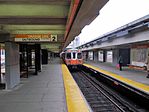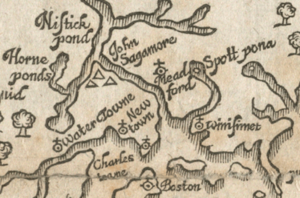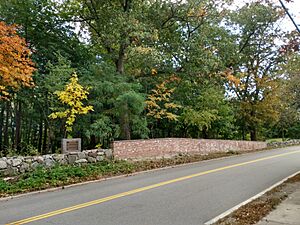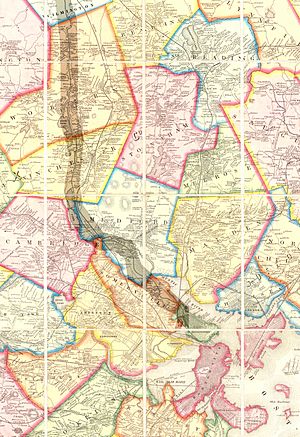Medford, Massachusetts facts for kids
Quick facts for kids
Medford, Massachusetts
|
||
|---|---|---|
|
City
|
||
|
Left-right from top: Medford Square, Medford High School, Eaton Hall of Tufts University, Wellington MBTA station
|
||
|
||
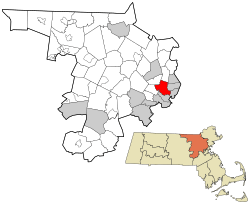
Location in Middlesex County in Massachusetts
|
||
| Country | ||
| State | ||
| County | Middlesex | |
| Region | New England | |
| Settled | 1630 | |
| Incorporated | 1630 | |
| City | 1892 | |
| Government | ||
| • Type | Mayor-council city | |
| Area | ||
| • Total | 8.66 sq mi (22.43 km2) | |
| • Land | 8.10 sq mi (20.98 km2) | |
| • Water | 0.56 sq mi (1.45 km2) | |
| Elevation | 14 ft (4 m) | |
| Population
(2020)
|
||
| • Total | 59,659 | |
| • Density | 7,366.22/sq mi (2,844.14/km2) | |
| Time zone | UTC−5 (Eastern) | |
| • Summer (DST) | UTC−4 (Eastern) | |
| ZIP Codes |
02153, 02155–02156
|
|
| Area code(s) | 781/339 | |
| FIPS code | 25-39835 | |
| GNIS feature ID | 0612778 | |
| Website | https://www.medfordma.org/ | |
Medford is a city in Massachusetts, located about 7 miles northwest of downtown Boston. It sits along the Mystic River in Middlesex County. In 2020, about 59,659 people lived in Medford. It is also home to Tufts University, a well-known college.
Contents
History of Medford
Early Indigenous History
For thousands of years, Native Americans lived in the area that is now Medford. The Naumkeag used this land as their winter home. They grew corn and built fishing traps along the Mystic River.
A Naumkeag leader named Nanepashemet was killed in a war in 1619. He was buried in what is now Medford. Later, a sickness brought by Europeans greatly reduced the native population. After this, Nanepashemet's widow, known as the Squaw Sachem of Mistick, became the leader. She sold large parts of the Naumkeag land to English settlers. In 1639, the land that became Medford was bought by the Massachusetts General Court.
Settlement in the 1600s
English colonists first settled Medford in 1630. It was part of Charlestown in the Massachusetts Bay Colony. The first name for the settlement was "Mistick," from the native name for the river. Later, it was renamed "Meadford." This name might have come from "meadow by the ford" (a shallow river crossing).
In 1634, a large area north of the Mystic River became a private farm. It belonged to Matthew Cradock, a former governor. South of the river was Ten Hills Farm, owned by John Winthrop, another governor.
The first bridge across the Mystic River was built in 1637. It was a toll bridge where people paid to cross. This bridge was very important for travel into Boston from the north. It was the only bridge over the Mystic River until 1787. The bridge has been rebuilt several times since then.
Medford was first governed as a private area. But as more people moved in, they started making their own decisions. By 1674, they elected a local board. In 1689, they chose a person to represent them in the government. The town also built its own religious meeting room in 1690.
Growth in the 1700s and 1800s
The population of Medford grew from 230 people in 1700 to 1,114 in 1800. After 1880, it grew very quickly, reaching over 18,000 by 1900. Farms were sold and turned into areas for homes and businesses.
More government services were added as the population grew. These included schools, police, and a post office. New technologies like gas lighting, electricity, and telephones also arrived. Tufts University was started in 1852.
Medford became a city in 1892. It was a busy place for making things. Factories produced tiles, crackers, bricks, and rum. Famous clipper ships, like the White Swallow, were also built here.
Transportation Development
In the 1600s, Medford had only a few main roads. But the road network grew a lot in the 1700s and 1800s. New turnpikes (toll roads) were built, which later became public streets.
Other big transportation projects helped Medford grow. The Middlesex Canal opened by 1803, allowing boats to travel. Railroads arrived in the 1830s and 1840s, connecting Medford to Boston.
Horse-drawn streetcars started running in 1860. These later became electric trolleys in the 1890s. Today, Interstate 93 runs through the city, built between 1956 and 1963.
The Spongy Moth Story
In 1868, a French scientist named Leopold Trouvelot was trying to breed better silkworms. He was working with spongy moths at his home in Medford. Some of these moths escaped. Within ten years, the insects had eaten many leaves in the area. The spongy moth then spread across North America.
Famous Holiday Songs
Medford is linked to two well-known holiday songs.
James Pierpont is said to have written "Jingle Bells" in Medford. He supposedly wrote it after watching a sleigh race from Medford to Malden. He copyrighted the song later while living in Georgia.
Another resident, Lydia Maria Child, wrote the poem that became the song "Over the River and Through the Wood". It was inspired by her trips to her grandparents' house in the area.
Other Notable Facts
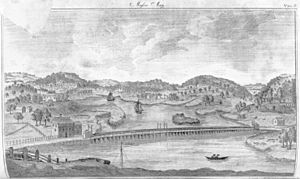
Paul Revere rode through Medford during his famous midnight ride. An annual event re-enacts this historic journey.
The Peter Tufts House is believed to be the oldest all-brick building in New England. Another important site is the "Slave Wall" on Grove Street. It was built by "Pomp," an enslaved person. The Royall House and Slave Quarters is a historic museum. It was once owned by a founder of Harvard Law School. George Washington and other soldiers used the house during the American Revolutionary War.
George Luther Stearns was an important industrialist and abolitionist. He helped recruit soldiers for the Union Army during the American Civil War.
Medford was also home to Fannie Farmer, who wrote a very famous cookbook. James Plimpton invented the first practical four-wheeled roller skate here in 1863. This invention started a roller skating craze.
The famous pilot Amelia Earhart lived in Medford in 1925. She worked as a social worker.
Michael Bloomberg, a successful businessman and former Mayor of New York City, grew up in Medford. He attended Medford High School.
Geography and Neighborhoods
Medford is located at 42°25′12″N 71°6′29″W / 42.42000°N 71.10806°W. The city covers about 8.6 square miles. About 8.1 square miles is land, and 0.5 square miles is water.
Part of the Middlesex Fells Reservation is located in Medford. This large park is shared with other nearby towns. The Mystic River flows through the middle of the city.
Medford's Neighborhoods
People in Medford often identify with their specific neighborhood. Some of these include:
- West Medford
- Fulton Heights/The Heights (North Medford)
- Wellington (East Medford)
- Glenwood
- Lawrence Estates
- South Medford
- Medford Hillside
- Tufts University (mostly located on Medford Hillside)
Population and People
| Historical population | ||
|---|---|---|
| Year | Pop. | ±% |
| 1790 | 1,029 | — |
| 1800 | 1,114 | +8.3% |
| 1810 | 1,443 | +29.5% |
| 1820 | 1,474 | +2.1% |
| 1830 | 1,755 | +19.1% |
| 1840 | 2,478 | +41.2% |
| 1850 | 3,749 | +51.3% |
| 1860 | 4,842 | +29.2% |
| 1870 | 5,717 | +18.1% |
| 1880 | 7,573 | +32.5% |
| 1890 | 11,079 | +46.3% |
| 1900 | 18,244 | +64.7% |
| 1910 | 23,150 | +26.9% |
| 1920 | 39,038 | +68.6% |
| 1930 | 59,714 | +53.0% |
| 1940 | 63,083 | +5.6% |
| 1950 | 66,113 | +4.8% |
| 1960 | 64,971 | −1.7% |
| 1970 | 64,397 | −0.9% |
| 1980 | 58,076 | −9.8% |
| 1990 | 57,407 | −1.2% |
| 2000 | 55,765 | −2.9% |
| 2010 | 56,173 | +0.7% |
| 2020 | 59,659 | +6.2% |
| 2023* | 58,744 | −1.5% |
| * = population estimate. Source: United States Census records and Population Estimates Program data. Source: |
||
Medford has a diverse population. Many people of Irish heritage live in the city. South Medford is known for its Italian community. West Medford is a wealthier area and has a historic African-American neighborhood.
Between 2021 and 2022, Medford was ranked as one of the fastest-growing cities in the United States.
Education in Medford
Medford has many schools, both public and private.
- Elementary Schools
-
- Public
- Missituk Elementary School
- Brooks Elementary School
- John J. McGlynn Elementary School
- Milton Fuller Roberts Elementary School
-
- Private (non-religious)
- Eliot-Pearson Children's School (Pre-K–2)
- Gentle-Dragon Preschool (Pre-K)
- Merry-Go-Round Nursery School (Pre-K)
- Play Academy Learning Center (Pre-K–K)
- Oakland Park Children's Center (Pre-K)
- Six Acres Nursery School (Pre-K–K)
-
- Private (religious)
- St. Joseph's (K–8)
- St. Raphael's (Pre-K–8)
- Middle Schools
- John J. McGlynn Middle School
- Madeline Dugger Andrews Middle School
- High Schools
-
- Public
- Medford High School
- Medford Vocational Technical High School
- Mascot: Mustang
- College
-
- Private
- Other Education
- The Greater Boston Japanese Language School holds classes at Medford High. This school helps Japanese students learn their language.
Transportation in Medford
Medford has several public transportation options. Three MBTA subway stations are in the city: Wellington (on the Orange Line), and Medford/Tufts and Ball Square (on the Green Line). The MBTA Commuter Rail also stops at West Medford. Many MBTA bus routes serve the city.
Interstate 93 runs through Medford. Several state roads also pass through, including Routes 16, 28, 38, and 60.
Places to Visit in Medford
- Tufts University: A major university with its campus partly in Medford. It provides jobs and community service projects for the city.
- Royall House and Slave Quarters: This is the only surviving slave quarters in Massachusetts. It is a museum in a house built in 1692.
- The Unitarian Universalist Church of Medford: This was Medford's first religious community, started in 1690.
- Amelia Earhart residence: The home of the famous pilot at 76 Brooks Street.
- Grandfather's House: A historic home connected to the song "Over the River and Through the Wood."
- Jingle Bells historical marker: A sign on High Street marking the rumored spot where the song was written.
- Salem Street Burying Ground: A historic cemetery.
- Old Ship Street Historic District: An area with many old homes along Riverside Ave.
- United States Post Office–Medford Main: A historic post office building from 1937.
Famous People from Medford
Medford has been home to many notable people:
- Belinda Sutton: An early activist for reparations for enslaved people.
- Michael Bloomberg: A successful businessman and former Mayor of New York City.
- Lydia Maria Child: An anti-slavery activist and writer of the poem "Over the River and Through the Woods."
- Amelia Earhart: A pioneer aviator who lived in Medford as a young woman.
- Fannie Farmer: A famous culinary expert and cookbook author.
- Paul Geary: Former drummer for the band Extreme and a music manager.
- John Hancock Sr.: Medford's first ordained preacher, and grandfather to the famous John Hancock.
- Robert Kelly: A well-known comedian.
- Maria Menounos: A media personality and actress.
- Bill Monbouquette: A former Major League Baseball pitcher for the Red Sox.
- John Forbes Nash: A Princeton professor and Nobel Prize winner in Economics.
- Alexis Ohanian: The co-founder of Reddit.
- James Pierpont: The writer of "Jingle Bells."
- Isaac Royall, Jr.: An 18th-century benefactor of Harvard and a major enslaver in Massachusetts.
- Claude Shannon: A scientist known as the "father of Information Theory."
- Clifford Shull: A Nobel Prize-winning American physicist.
- George Luther Stearns: An industrialist and abolitionist who helped recruit soldiers during the Civil War.
- Keith Tkachuk: A well-known NHL hockey player.
See also
 In Spanish: Medford (Massachusetts) para niños
In Spanish: Medford (Massachusetts) para niños





